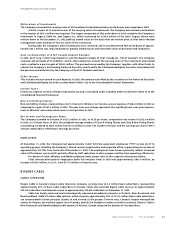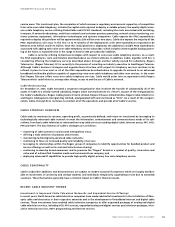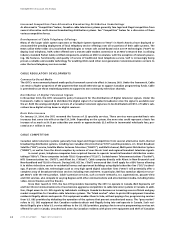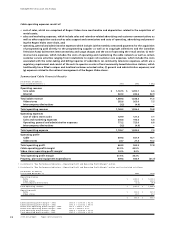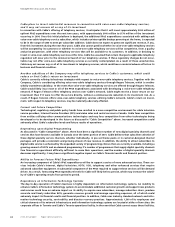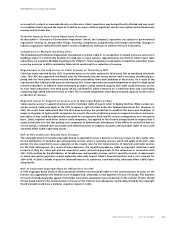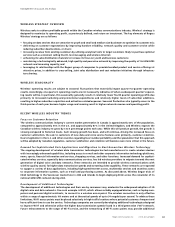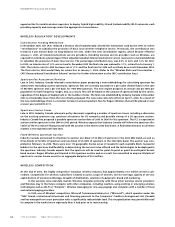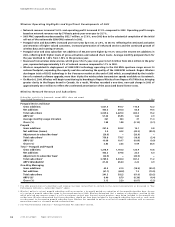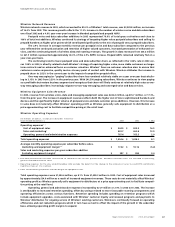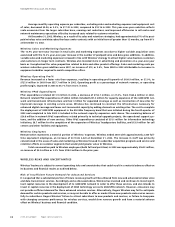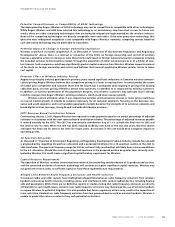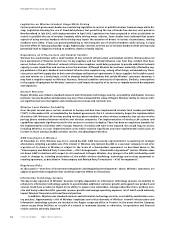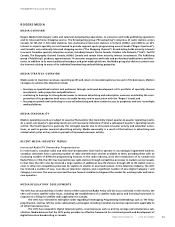Rogers 2003 Annual Report Download - page 43
Download and view the complete annual report
Please find page 43 of the 2003 Rogers annual report below. You can navigate through the pages in the report by either clicking on the pages listed below, or by using the keyword search tool below to find specific information within the annual report.
2003 Annual ReportRogers Communications Inc. 41
as a result of a natural or manmade disaster or otherwise, Cable’s operations may be significantly affected and may result
in a condition that is beyond the scope of its ability to recover without significant service interruption and commensurate
revenue and customer loss.
Potential Impacts from Future Regulatory Decisions
As discussed in “Overview of Government Regulation” above, the Company’s operations are subject to governmental
regulations relating to, among other things, licensing, competition, programming and foreign ownership. Changes in
industry regulations could affect the Cable’s results of operations and have an adverse effect on its business.
Competition in Multiple Dwelling Units
The Broadcasting Distribution Regulations (Canada) do not allow Cable or its competitors to obtain exclusive contracts in
buildings where it is technically feasible to install two or more systems. Approximately one-third of Cable’s basic cable
subscribers are located in Multiple Dwelling Units (“MDUs”). These regulations could lead to competitive subscriber losses
or pricing pressures in MDUs serviced by Cable which could result in a reduction of revenue.
Requirement to Provide Access to Cable Systems to Third Party ISPs
Cable has been required by the CRTC to provide access to its cable systems by third party ISPs at mandated wholesale
rates. The CRTC has approved cost-based rates for third party Internet access service and is currently considering pro-
posed rates for third party interconnection and other outstanding terms and conditions of the service. As a result of the
requirement that Cable provide access to third party ISPs, it may experience increased competition at retail for high-speed
Internet subscribers. In addition, these third party providers utilize network capacity that Cable could otherwise use for
its own retail subscribers. One third party ISP has connected to Cable’s network on a wholesale basis and is providing
competing high-speed Internet services at retail. The increased competition and reduced network capacity could result in
a reduction of revenue.
Required Access to Support Structures and to Municipal Rights of Way
Cable requires access to support structures and to municipal rights of way in order to deploy facilities. Where access can-
not be secured, Cable may apply to the CRTC to obtain a right of access under the Telecommunications Act. However, in
2003, the courts have determined that the CRTC does not have the jurisdiction to establish the terms and conditions of
access to the poles of hydroelectric companies. As a result, the costs of obtaining access to support structures and munic-
ipal rights of way could be substantially increased on a prospective basis and for certain arrangements on a retroactive
basis. Cable, together with other Ontario cable companies, has applied to the Ontario Energy Board to request that it
assert jurisdiction over the fees paid by such companies to hydroelectric distributors. If the efforts to control the fees are
not successful, increased costs associated with obtaining access to support structures and municipal rights of way could
adversely affect Cable’s operating results.
Risk of Retransmission Royalty Rate Changes
The Copyright Board of Canada (Copyright Board) is expected to issue a decision in the near future on the royalty rates
for the distribution of Canadian pay and specialty services, and U.S. specialty services, which will apply to the 2001–2004
period. It is also expected to issue a decision on the royalty rates for the retransmission of television and radio services
for the 2004–2008 period. As a result of these decisions, the royalties payable by Cable to copyright collectives could
increase. If they do, Cable will also be required to make retroactive payments to the collectives in connection with
2001–2003 royalties for the distribution of Canadian pay and specialty services, and U.S. specialty services. A requirement
to make retroactive payments would materially adversely impact Cable’s financial position and a rate increase for
2004–2008, if Cable is unable to pass the increased rates to its customers, could materially, adversely affect Cable’s oper-
ating results.
Risk of Expanded Copyright Royalty Obligations for ISPs
A 1999 Copyright Board decision that considered whether ISPs should be liable for the communication of music on the
Internet was appealed to the Federal Court of Appeal and, ultimately, to the Supreme of Court of Canada. The Supreme
of Court of Canada heard this appeal in December 2003 and is expected to issue its decision in the summer of 2004. Should
ISPs be found liable for the communication of music on the Internet, any subsequent royalty determined by the Copyright
Board (Canada) could have a material, negative impact on Cable.
Management’s Discussion and Analysis


